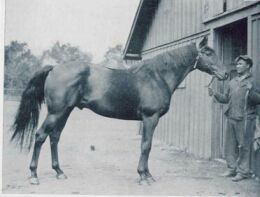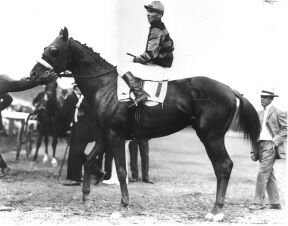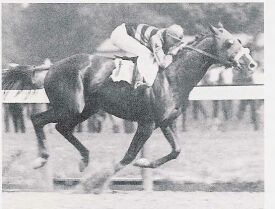

Sir Barton was a blaze faced chestnut colt by the leading sire *Star Shoot, a son of English Triple Crown winner Isinglass. His dam was the stakes producing mare Lady Sterling, a seventeen year old daughter of the great Hanover. He was bred by John E. Madden and Vivian Goach, and was foaled at Madden's Hamburg Place in Lexington during the spring of 1916. The farm was also the birthplace of Kentucky Derby winners Old Rosebud, Paul Jones, Zev, and Flying Ebony.
While racing for Madden as a juvenile, Sir Barton was unplaced in the Tremont, Flash, United States Hotel, and Sanford Memorial Stakes. Barton had yet to finish in the money when he was sold privately to Canadian Naval Commander John Kenneth Levison Ross for the sum of $10,000 during his two-year-old career. Ross had inherited a reported twelve million dollars from his father, James Ross, a founder of the Canadian Pacific Railways, and was putting the money to use by building an already powerful racing stable. His horses included that season's top two-year-old, Billy Kelly, as well as Cudgel, who shared the handicap championship with W.S. Kilmer's Sun Briar in 1919, and the champion filly Milkmaid.
Harvey Guy Bedwell, known as "Hard Guy," trained Sir Barton and Commander Ross' other horses. Bedwell had worked with horses since the age of thirteen, when he had earned a living as a cowpuncher in his native state of Oregon. His first experience with racehorses had come on the western circuits, and when he moved east, Bedwell became the leading trainer in the country, topping the earnings list in his first year.
Sir Barton had such soft, shelly hooves that he often lost shoes during races, even throwing all four shoes in one event. Piano felt was inserted between his shoe and hoof in an attempt to reduce the pain caused by hard, fast racetracks. The constant discomfort may have been part of the cause of Sir Barton's unpleasant disposition. The colt was a grouchy snob, disliking people, horses, and other animals with the only possible exception being his groom, Toots Thompson.
He also detested workouts, only extending himself when pushed by other horses, and his trainer was forced to use relays of horses to chase him around the track each morning. As Guy Bedwell often explained in frustration, "To get him fit you have to half kill him with work - and a lot of other horses as well." J.K.L. Ross's son may have summed it up best when he described Sir Barton as "an irascible, exasperating creature."
Wearing the colors of J.K.L. Ross, Sir Barton raced twice more as a two-year-old. With Earl Sande in the saddle for the first time, he was out of the money behind Eternal in the Hopeful Stakes, but then turned in a strong performance in his final race as a juvenile. Sir Barton surprised many by closing strongly to finish second behind Dunboyne in the Futurity Stakes.
Sir Barton was still a maiden when he was entered in
the 1919 Kentucky Derby as a rabbit for the favored Billy
Kelly. Commander Ross had bet $50,000 that his colt Billy
Kelly would beat Eternal in the 1919 Kentucky Derby. As
juveniles, the colts had shared championship  status, and
Ross was anxious to prove his horse was best. The plan
was for Sir Barton, ridden by Johnny Loftus, to set an
early pace, tiring out Eternal and Under Fire, so that
Billy Kelly could come from behind to win. It backfired
when Billy Kelly couldn't catch Sir Barton in the stretch,
and finished second, five lengths behind his stablemate.
Eternal, however, had finished tenth, and Commander Ross
collected on his bet.
status, and
Ross was anxious to prove his horse was best. The plan
was for Sir Barton, ridden by Johnny Loftus, to set an
early pace, tiring out Eternal and Under Fire, so that
Billy Kelly could come from behind to win. It backfired
when Billy Kelly couldn't catch Sir Barton in the stretch,
and finished second, five lengths behind his stablemate.
Eternal, however, had finished tenth, and Commander Ross
collected on his bet.

Only four days after his win at Churchill Downs, Sir Barton ran in the Preakness Stakes, romping to a four length victory over Eternal while Dunboyne, winner of the previous year's Futurity Stakes, finished eleventh. The May 15 edition of the Baltimore Sun carried the following poetic explanation for his victory:
"He was bred in old Kentucky, Where the meadow's grass is blue, And he was trained in Maryland, The whole winter through. He won the Derby in the mud, Which proved his speed was true, And now he's won the Preakness, Sir Bart, hats off to you!"
On May 24, Sir Barton beat Eternal once again, this time in the Withers Stakes. When he captured the Belmont Stakes in the American record time of 2:17 2/5 for a mile and three sixteenths, he became America's first Triple Crown winner, although the series of races wasn't known as the Triple Crown until the 1930's. Beneath a headline that declared "SIR BARTON EASILY WINS THE BELMONT: Amazing 3-Year-Old Not Extended, Yet Sets New Track Record for 1 3/8 Miles," The New York Times described Sir Barton's triumph:
"During the last eighth, Loftus sat still as a statue, holding his mount back as well as he could, but the beautiful chestnut could not be restrained entirely. He was endowed with the spirit of competition and ran straight and true to the end, pulling up without showing the least trace of weariness."
Sir Barton's first loss after the series came when he attempted to give weight away in the Dwyer Stakes, and was beaten by Purchase, later winner of the first Jockey Club Gold Cup. In the meantime, Billy Kelly was on his way to becoming a top sprinter, and became responsible for one of Sir Barton's five defeats that season when the pair met in a six furlong sprint at Havre de Grace. Sir Barton was quick to settle the score, however, when two days later, despite a 132 pound burden he easily handed defeat to his speedy stablemate in the Potomac Handicap.
AFter a game effort in which he finished second to The Porter on a heavy track, Sir Barton ran third behind Cudgel and Exterminator in the Havre de Grace Handicap.
In the Maryland Handicap, the Ross colt was required to give twenty seven pounds to Mad Hatter, a champion handicapper of later years, but proved his talent with a two length victory despite being forced wide. Mad Hatter sought vengeance for the defeat by scoring against Sir Barton in the Pimlico Autumn Handicap when jockey Johnny Loftus was forced to ease a sore Sir Barton in the homestretch.
With Clarence Kummer in the irons Sir Barton won the second and third races in the Pimlico Fall Serial, beating The Porter and Billy Kelly, and with a three-year-old record of eight wins in thirteen starts, Sir Barton successfully claimed both divisional and Horse of the Year honors.

As a four-year-old, Sir Barton debuted at Havre de Grace, running fourth behind stablemate Billy Kelly in the six furlong Belair Handicap. He then won an overnight handicap while giving eleven pounds to the champion filly Milkmaid, and, forced wide, ran third behind Wildair in the Marathon Handicap. He was forth in the Philadelphia Handicap while conceding thirty two pounds to the winner.
Sir Barton scored by a length under 132 pounds in the Rennert Handicap at Pimlico, then met the mighty gelding Exterminator in the Saratoga Handicap. Carrying 129 pounds, Sir Barton beat the older champion, despite giving him weight, in one of the finest races of his career.
Next came a loafing victory in the Dominion Handicap at Fort Erie under 134 pounds.
In the Merchants and Citizens Handicap, Sir Barton defeated Gnome and set a new American record of 1:55 3/5 for the mile and three sixteenths, despite a 133 pound impost. Sir Barton was the undisputed champion among the older horses, but a younger champion prevented his absolute dominance.
Man o' War's reputation had grown from that of a living legend to near immortal status as he reinforced his greatness with each brilliant victory during the 1920 season. He had yet, however, to challenge older horses. Naturally, fans clamored for a meeting between the two champions and racetracks vied for the opportunity to host the event. The two owners finally agreed to a match race at Kenilworth Park in Canada.
As the "Race of the Century" approached, both stables dealt with the problems of the publicity associated with the event, as well as rumors surrounding the soundness of their horses. Sir Barton also had a change of riders. After the hype and anticipation, the race itself was almost anti-climatic. Suffering defeat, the first Triple Crown winner began a tradition that was also honored by the Triple Crown winners War Admiral, Whirlaway, and Assault, all of whom also suffered defeat in great match races.
After Man o' War beat him in the 1920 Kenilworth Gold Cup, Sir Barton was unable to win a single race. He lost the Laurel Stakes to Blazes and The Porter, ran third behind Mad Hatter and Billy Kelly in Pimlico's Fall Serial #2, and finished second to Billy Kelly in the third Serial. Retired to stud, he was sold to B.B. and Montfort Jones, and stood at their Audley Farm in Virginia, where he sired several excellent fillies, including the 1928 Kentucky Oaks winner Easter Stockings.
In 1933, Sir Barton was sent to the U.S. Remount Station in Front Royal, Virginia, for reasons now unknown. Somehow he ended up at the Remount Station in Fort Robinson, Nebraska, standing stud for less than ten dollars. J.R. Hylton, who owned a few racehorses, bought the old champion and brought him home to his ranch in Douglas, Wyoming, where he passed away on October 30, 1937. He was originally buried near his paddock, with a simple sandstone headstone and a post and rail fence surrounding the plot, but in 1968 he was moved to the Washington Park in Douglas, where America's first Triple Crown winner now lies beneath a generic fiberglass statue of a horse, since the small park could not afford a real sculpture.
Many racehorses who achieve a certain level of fame receive affectionate nicknames from their fans. Man o' War was Big Red, and Exterminator answered to Old Bones. Yet perhaps as a result of his slightly less than lovable personality, Sir Barton was denied this honor. Author Marvin Drager later attempted to correct the slight, dubbing him "The Tender Toed Typhoon." Sir Barton was elected into the Hall of Fame in 1957, and was honored on the top half of the list on Blood-Horse magazine's Top 100 Racehorses of the Twentieth Century.
| Year | Starts | Wins | Seconds | Thirds | Earnings |
|---|---|---|---|---|---|
| Lifetime | 31 | 13 | 6 | 5 | $116,857 |
| Star Shoot | Isinglass | Isonomy | Sterling |
| Isola Bella | |||
| Dead Lock | Wenlock | ||
| Malpractice | |||
| Astrology | Hermit | Newminster | |
| Seclusion | |||
| Stella | Brother to Strafford | ||
| Mare by Toxophilite | |||
| Lady Sterling | Hanover | Hindoo | Virgil |
| Florence | |||
| Bourbon Belle | Bonnie Scotland | ||
| Ella D. | |||
| Aquila | Sterling | Oxford | |
| Whisper | |||
| Eagle | Phoenix | ||
| Au Revoir |



This text protected by all applicable copyright laws. Do not duplicate or distribute without written permission. © Spiletta42.